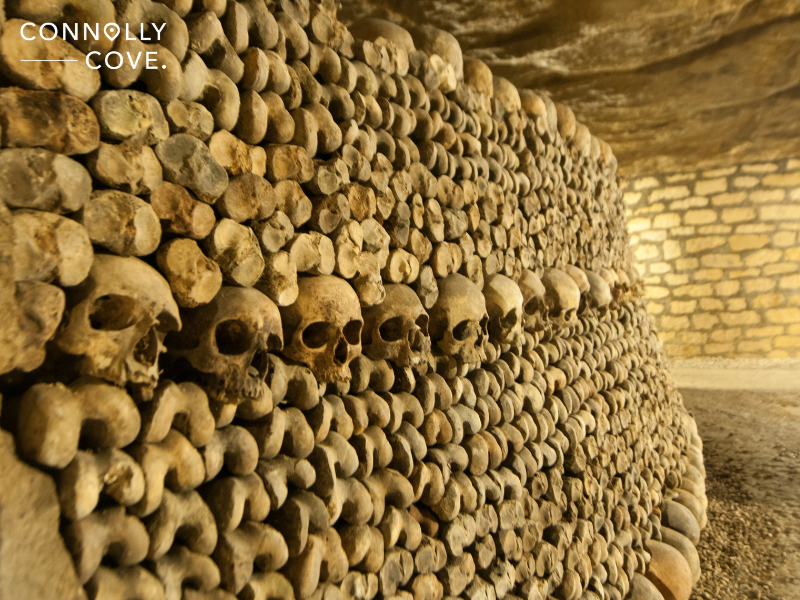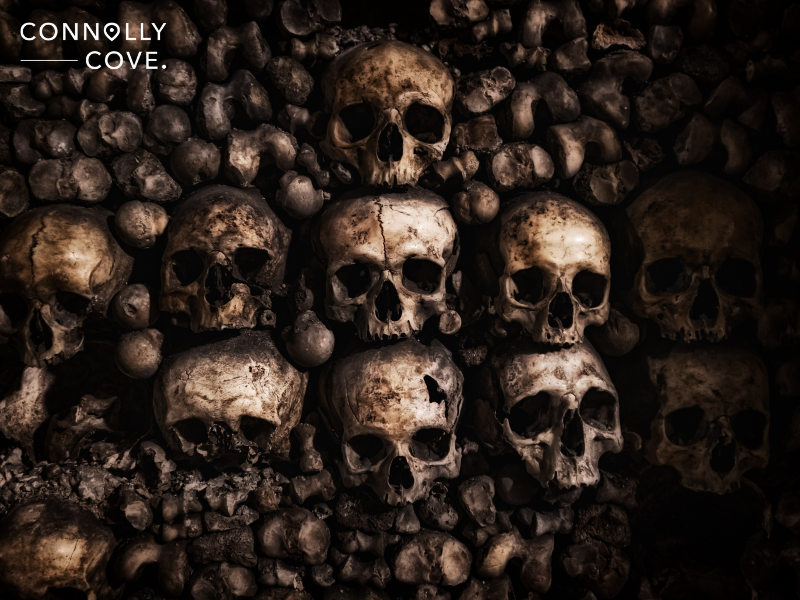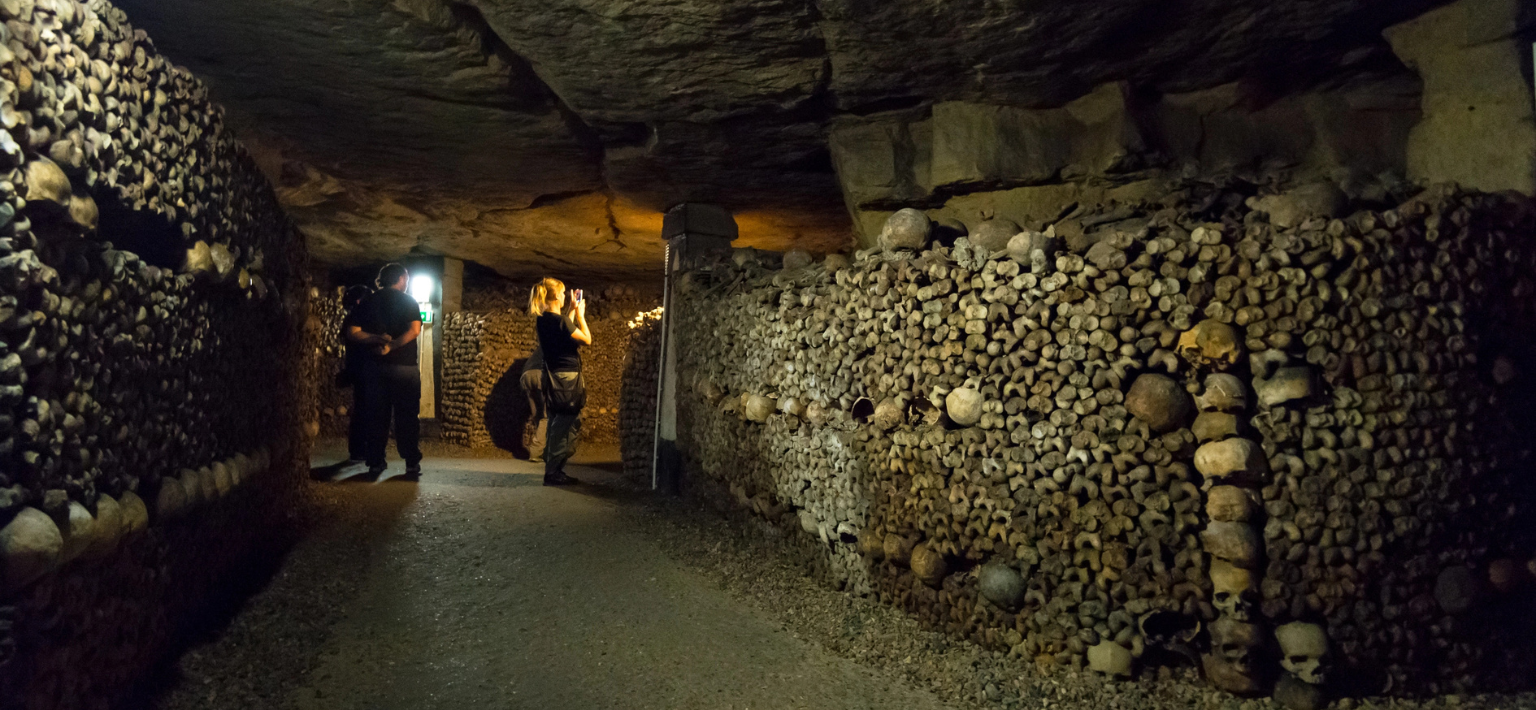Updated On: February 19, 2024 by Raghda Elsabbagh
Beneath Paris’s bustling streets lies a world shrouded in history and mystery—the Paris Catacombs. Imagine tracing your way through the hallowed 200-mile-long tunnels beneath Paris itself, where over six million souls dwell in their eternal sleep. Beyond the city’s iconic landmarks and bustling boulevards, these underground tunnels tell a tale of necessity, ingenuity, and a response to the challenges faced by Parisians in the 18th century.
Far more than a mere underground maze, the Paris Catacombs are a captivating tapestry woven with bones, history, and an enigmatic charm that beckons the curious to explore its depths. This blog offers to be your thorough compass guiding you through these ancient bone repositories—not only enriching your journey with intriguing historical titbits but also divulging secrets that promise to make this exploration undoubtedly worthwhile and quite thrilling indeed. Fancy embarking on a journey to this underground world?

Table of Contents
What are the Paris Catacombs?
The Paris Catacombs are a series of underground chambers and tunnels that run beneath the streets of Paris, France, serving as an ossuary. The Catacombs are famous for their macabre decorations, consisting of the bones of over six million people. The Paris Catacombs cover an area of about 200 miles. They are spread over several levels, with the deepest section reaching more than 100 feet underground.
History of the Paris Catacombs
The history of the Catacombs is much more complicated than their current use as a tourist attraction would suggest.
Unveiling the Origins: The Construction of the Paris Catacombs in the 18th century
It was the 1700s. Paris was expanding rapidly with a growing population of over 500,000 and a booming construction industry hungry for resources. Extensive quarrying took place beneath the surface to meet the demand for limestone. Little did the workers know that these quarries would eventually evolve into the intricate Catacombs we know today.
As Paris continued to expand, the sheer volume of extracted limestone created an extensive network of underground tunnels. This labyrinthine system would later serve a purpose far beyond the extraction of building materials.
Transformation from a Quarry to a Burial Site: What Led to the Catacombs Creation?
Enter the late 18th century. One of the challenges facing the city was what to do with its dead. The city’s cemeteries were overcrowded, unsanitary, and posed a serious public health risk. Something had to change, and change took the form of the Catacombs, which emerged as a creative response to this dilemma.
In 1786, to address this problem, the municipal authorities repurposed the abandoned quarries into an ossuary—an underground burial site to accommodate the remains of millions of Parisians. The tunnels and chambers dug out of the rock were enormous. The quarries extended for miles and were a perfect solution to the problem of overcrowded cemeteries.
Over several years, the city began moving the bones of its dead into the quarries, which were transformed into a vast underground burial site. The creation of the Catacombs was not without controversy. Some people objected to the idea of moving the dead from their original resting places, while others saw the Catacombs as a symbol of the city’s decay and decline. Nevertheless, the Catacombs effectively solved the problem of overcrowded cemeteries, and they remain an essential part of Paris’s history to this day.
Bones, Tunnels, and Art: Exploring the Architectural Elements of Paris Catacombs
Far from just a repository of bones, this underground labyrinth showcases a unique blend of design, structure, and artistic elements that make it a one-of-a-kind experience. Here are some of the architectural features of the Paris Catacombs:
Design and Structure of the Catacombs: Labyrinthine Tunnels and Passages
When descending into the cool, dimly lit depths of the Catacombs, what unfolds before you is a network of labyrinthine tunnels, passages, and chambers that stretch for miles beneath the City of Light. The Catacombs consist of a series of galleries and narrow corridors, some of which are only wide enough for one person to pass through at a time. The design is nothing short of ingenious, a testament to the architects who repurposed former quarries into this subterranean masterpiece.
Wandering through these tunnels, you’ll find yourself navigating a maze that seems to defy the logic of above-ground Paris. The tunnels are lined with carefully arranged stacks of bones and skulls, creating eerie walls that stretch for miles.
The Arrangement of Bones and Skulls

As you venture deeper into the Catacombs, the most striking feature of its design comes to life—the meticulous arrangement of bones and skulls. What might seem macabre at first glance is, in fact, a carefully orchestrated arrangement that speaks to both practicality and aesthetic sensibilities.
The bones are arranged decoratively, with skulls and femurs stacked neatly in rows and columns. In some cases, the bones create elaborate patterns and designs on the walls and ceiling. The bones are arranged carefully, creating an eerie yet oddly beautiful tableau unlike anything else.
Artistic Elements within the Catacombs: Decorative Arrangements of Bones
The decorative arrangements of bones are not only a functional way of storing the remains of the dead but also a form of art. The bones are arranged in elaborate patterns and designs that are often symmetrical and aesthetically pleasing. Bones become building blocks, creating a series of stunning, albeit eerie, sculptures—a surreal display that transforms the Catacombs into an underground art gallery.
Inscriptions and Plaques Honouring the Deceased
In addition to the decorative arrangements of bones, the Catacombs also feature inscriptions and plaques honouring the deceased. These inscriptions and plaques are a testament to the lives of those who once lived in Paris and are a reminder of the Catacombs’ historical significance.
Beyond Bones: The Cultural and Artistic Charms of Paris Catacombs
The Paris Catacombs have become integral to the city’s identity, connecting the present with a rich historical narrative.
Impact on French Culture and Identity
The impact of the Paris Catacombs on French culture and identity is significant. The Catacombs represent a symbolic representation of mortality and the transient nature of life. They remind us of human life’s fragility and death’s inevitability.
The gloomy depths of the Catacombs have inspired French literature and art, with many artists and writers drawing inspiration from the eerie and haunting atmosphere of the tunnels. From Gothic novels to contemporary artworks, the underground realm has sparked a creative flame that illuminates the darker facets of human experience.
Modern Use As a Tourist Attraction
The Paris Catacombs have undergone renovations over the years. They are now one of the top tourist attractions in Paris, offering visitors an intriguing and historical experience. Today, people from all over the world come to explore this unique underground ossuary.
Visitor Experience and Guided Tours
The visitor experience is unique and memorable. With audio guides available, you can immerse yourself in the stories behind these ancient ossuaries while exploring the historical architecture of this captivating underground labyrinth.
Step into the shoes of a curious traveller, and let’s venture into the depths below Paris. A narrow spiral staircase will lead you deeper into the darkness, away from the hustle and bustle of the city above. As you reach the bottom, you will find yourself in a labyrinth of tunnels lined with stacked bones and eerie sculptures made from human remains. You’ll discover bone-filled chambers and hidden burial sites surrounded by historical architecture. The eerie atmosphere becomes more palpable, and your adrenaline starts to spike. Millions of stacked bones created a macabre yet mesmerising sight. Chilling and fascinating!
Tips for Visiting Paris Catacombs
Some of the tunnels are closed off to the public due to safety concerns, but visitors can explore about 1.5 miles of the Catacombs on a guided tour. Here are some tips to fully enjoy your visit to the Paris Catacombs. Firstly, make sure to wear comfortable shoes as there is a fair amount of walking and stair-climbing. Secondly, bringing a flashlight or using the one on your phone is a good idea, as the Catacombs can be pretty dark.
Additionally, consider purchasing tickets in advance to avoid long queues. Once inside, follow the provided audio guide for interesting historical insights. Finally, respect the solemn atmosphere and remember not to touch any bones or sculptures.
How Much Do Tickets Cost to Tour Through the Paris Catacombs?
The ticket price for exploring Paris Catacombs ranges from €16 to €18. If you want the audio guide with your ticket, this will cost you €37.5.
Cool Facts About the Paris Catacombs
- Secret Entrance: There is a secret entrance to the Catacombs called “La Plage” (The Beach), accessible through the Parisian sewer system. Exploring the Catacombs through this entrance is illegal and dangerous.
- Hidden Cinema: In 2004, a group of people set up a secret cinema within the Catacombs, equipped with a bar and a makeshift movie theatre. The authorities eventually discovered and shut it down.
- Cataphiles: Urban explorers known as “cataphiles” frequently venture into the Catacombs, exploring the vast network of tunnels and chambers. Some even organise events and parties in the underground space.
- Reservoir of French Resistance: During World War II, the Catacombs served as a refuge and headquarters for the French Resistance. Its hidden location provided an ideal place for planning and organising activities against the German occupation.
- Skulls Stolen by Thieves: In 2017, thieves broke into the Catacombs and stole several skulls. They were later caught, and the stolen remains were recovered.
- Museum of the Sewers: The Catacombs are connected to the Paris Sewer Museum, providing an intricate glimpse into the city’s underground history.
- Philibert Aspairt: In the 18th century, a porter named Philibert Aspairt got lost in the Catacombs and was not found until 11 years later, when his body was discovered. His story adds a mysterious and haunting layer to the Catacombs’ history.
In conclusion, exploring the mysterious Paris Catacombs is a captivating journey into the underground ossuaries of the city. With their rich history, these hidden burial sites offer visitors an opportunity to dive into the depths of Paris’s past. Descending into the Paris Catacombs, you can’t help but be awed by the ancient architecture and eerie atmosphere that make this experience truly unforgettable.







